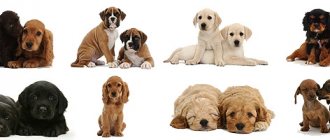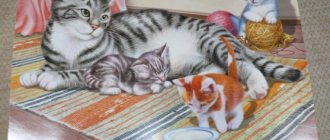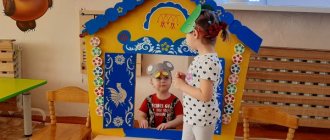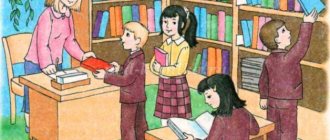Summary of educational activities in the senior group of the preschool educational institution “Winter Fun” (composing a story based on a picture)
- January 3, 2021
Program content:
- Improve children's ability to write a descriptive story based on a picture.
- Strengthen the ability to present the content of a picture in detail and logically; independently invent events preceding and following those depicted in the picture.
- Practice composing sentences and incorporating them into a coherent statement.
- To develop children's coherent speech in story writing, attention, and memory.
- Develop the ability to listen to the answers of your comrades to the end, without shouting.
Materials and equipment: painting “Winter Fun”, stereo system, DVD with music by A. Vivaldi “Winter”, board, magnets. Preliminary work: conversations with children about winter and winter activities, selection of definitions, selection of synonyms for the word quickly - swiftly, dashingly, at full speed, like an arrow, in an instant, immediately, etc.
GCD move
Educator: Guys, let's guess the riddle and find out what we will talk about. So listen to the riddle.
I dusted the paths, decorated the windows, and gave joy to the children. And I went for a sledding ride. (Winter).
A short conversation on the following questions:
- Guys, what is this riddle about? (About winter).
- What is our winter like? (Severe, white, silver, fluffy, snowy, frosty, cold).
- What happens in winter? (Snow is falling, the wind is howling, rivers are freezing).
Well done guys, you remembered all its signs.
Exercise “Name the action” (with a ball).
Educator: I will say an unfinished sentence, and the one to whom I pass the ball will finish the word I didn’t say.
- In winter there is a snowstorm... (sweeping).
- At night the wind in the pipes... (howls, howls).
- From a snow cloud, snowflakes... (fall, fly, spin).
- There is a hungry wolf in the forest in winter... (howls).
- For the winter, the bear is in a den...... (falls asleep).
- Frost on the cheeks and nose... (stings).
- In winter, the water in the river... (freezes).
- Frost on tree branches... (glitters).
- In winter, snow is all around... (covers).
- Trees in winter... (sleep).
- Grass under the snow in winter... (warming up).
- In winter, insects... (hide).
Well done! You know winter phenomena well. Do you know what winter cannot be without? Let's continue playing.
Game "Third Man".
Educator: Now listen to my winter words, one of the three words will be superfluous, you need to name it, explaining your decision:
1. January, February, winter.
2. Snowballs, sleds, skates.
3. Blizzard, skiing, frost.
4. Snowball, snowman, bullfinch.
Right! What smart people and smart girls! You know everything about winter and winter phenomena. Guys, do you think winter is good or bad?
Suggested children's answers:
- It’s good in winter because there is a lot of snow and you can build a snowman and have snowball fights.
- It’s good in winter, you can sled down the mountain.
- In winter comes the best holiday - New Year, and this is very good.
- It’s bad in winter, when it’s very cold, we don’t go for walks.
- Birds feel bad in winter - they are cold and have nothing to eat.
- In winter it’s nice and fun, we go skiing and play hockey.
For each answer, the teacher draws a circle of snowballs “good”, “bad”.
Educator: Guys, look at the snowballs and draw a conclusion: which snowball is bigger? There are more good things in winter: the kids love to play, have fun, and play sports.
But what games do they like to play? I'll tell you some riddles :
My new friends are both brilliant and light, And they frolic with me on the ice, and are not afraid of the frost. (Skates).
They run forward with their noses in the air. Two stripes follow them. (Skis).
Oh, it's snowing! I'm bringing out my friend horse. I fly down the hill on it, and drag it back. (Sled).
Physical exercise.
- “Winter has finally come, (children spread their arms to the sides)
- The houses have become white (they fold their hands over their heads)
- It's snowing outside (move hands from top to bottom)
- A janitor sweeps the street (imitate)
- We are sledding (squat, arms extended forward)
- We write circles on the skating rink (put our hands behind our backs and spin slowly)
- Skiing deftly, (imitate)
- And we all play snowballs. (They make and throw snowballs)"
It's good in winter - a lot of games and fun. What can you do in winter? (Sledding, skiing, skating, building forts, making snowmen, etc.).
Dynamic pause.
Educator: Now we will play. You (points to half of the group) will be snowflakes, and you (the other half) will be the wind. The game is repeated twice, the subgroups change roles. Snowflakes are spinning, running on tiptoes, the breeze is resting. As soon as I say “the breeze has woken up,” the breeze blows, shhh, and the snowflakes settle.
Didactic ball game “Name it kindly”
(Children catch the ball, give answers to the teacher with a diminutive suffix):
- Snow - snowball
- wind - breeze
- star – asterisk
- winter - winter
- Christmas tree - Christmas tree
- snowflake - snowflake
- sun - sunshine
- snowman - snowman
- star - asterisk.
Educator: Many poets, writers and artists depicted winter in their works. And in our art gallery there is a picture about winter. (The teacher draws the children’s attention to the painting “Winter Fun”).
Educator: In a real art gallery there is a guide who tells all visitors interestingly about the paintings. Do you want to try to become a tour guide, compose and tell a story based on this picture?
Communication by picture:
- What time of year is shown here?
- Why did the children come to the hill, and what happened there?
- What were the children doing? (Children sledding down the mountain, making a snow woman, skiing, playing snowballs).
- How do the guys play in winter? (Fun, joyful, friendly, interesting, fervent).
- At the end of the story, tell me what mood the guys were in and why you decided that way.
– Remember the words that will decorate your story and make it interesting. Do not forget that children can be called differently when telling stories (children - kids, guys, boys and girls, they).
Children's stories based on the picture.
Reflection.
- What did we do today? You did your best today and made up different interesting stories. It seems to me that this story will be interesting for your moms and dads to listen to at home.
As a farewell gift, I want to give you pictures – “Winter Fun” coloring pages. Winter has only white paint, but you can color them with your colored pencils.
Author: Gumerova Rezeda Khalidovna, teacher at MBDOU DS KV “Beryozka”, Novy Urengoy, Tyumen region.
Conversation on the painting by A. K. Savrasov “The Rooks have Arrived”
Topic: Conversation on the painting by A. K. Savrasov “The Rooks have Arrived”
Goals:
-to help children see and feel the soulful beauty of their native Russian nature in the film “The Rooks Have Arrived”;
— learn to establish semantic associations, answer questions independently;
- use common sentences with homogeneous definitions in speech...
Preliminary work
- Acquaintance with poems about spring by F.I. Tyutchev “Spring”, “Spring Waters”, A.N. Pleshcheev “Spring”, I. Tokmakova “Spring”
- Reading the story by E. Shima “Stone, stream, icicle and sun”
- Guessing riddles about spring.
- Repetition of migratory birds - the game "Fly away - arrived."
- Repetition of the spring months - the game "Before - between - for"
Equipment
Reproduction of A.K. Savrasov’s painting “The Rooks Have Arrived”
Lesson plan. Introduction
.
Invitation to the opening day.
I invite you to the opening day. Vernissage is a place in a museum where paintings are shown. Imagine that we are in a large hall of a museum. And I am your guide, I will introduce you to the picture. True, there will be only one picture, but it will be very famous. The teacher opens the picture on the easel.
Silent holistic perception.
This painting is called “The Rooks Have Arrived”, it was painted by Russian artist Alexey Kondratyevich Savrasov. Why is it so famous, why do people come from different cities and even different countries to see it? What is her secret?
Today I will help you reveal its secrets.
A conversation based on a picture, complicated by grammatical tasks.
- Tell us about the birch trees in the foreground. What are they?
What's happening on the birches?
What can you say about the lone rook on the left, near the old gnarled birch tree?
Who is the main character of the picture? Why?
This is the first secret, the rooks discovered spring, early, not bright, still with cold days, remnants of snow.
2. But what happened to the snow, what is it like under the birches, in the fields? You can say about him in lines from poetry: “The snow is no longer the same: It has darkened in the field...”
The artist paints the picture in cold colors, there are no bright greens or bright colors here. And yet there is a beauty of spring in her. Here's the second secret.
3. Let's go deeper into the picture.
Let's walk along the right bank of the river. What's there?
Village. What kind of houses? (high, low). What are houses and barns made of?
(wooden). What is in the middle of the village? High bell tower. What is it built from (stone, white). What to call it in one word?
White stone. What can you see behind it? (End of the village.) What's behind the village? (Field) Tell us about it. Beyond the field you can see a thin strip of forest. This is the horizon line. She merges with the high sky. That's how far we've come. This is the third secret. The picture has depth and height. The bell tower is high, but the sky is even higher. It has a lot of space. The artist divided it in half with the horizon line. One half is everything that grows and stands on the earth, the other half is the sky.
4.Look at the sky in the picture. What is it like?
The sky is covered with clouds. What can they be called? (Cover). However they are tall. What color are they? (white, gray...) In a word - white-gray. But in the left corner of the picture the clouds parted, as if the wind had torn them apart, we can see the edge of what? (blue sky). Such blue skies only happen in spring.
It’s like a window and the artist let in a lot of air smelling like spring. Smells live in the painting. Which? (The smell of melting snow, fresh air, the smell of swollen spring buds, the smell of warm earth) Here is another secret.
5. In spring the air is fresh and fragrant. I want to breathe deeply, enjoy spring, sing, smile, laugh. Even the rooks are happy with her. They scream, make noise... What else can sound in a picture where the sounds of nature live? (The river is noisy, murmurs, the branches are noisy, the wings of rooks are noisy, the wind is noisy) The voices of birds, the noise of nature live in the picture.
This is the new secret we have discovered.
Spring is coming, spring is coming!
We are the messengers of young spring
She sent us ahead!..
And this key will show us what you remember while looking at the painting “The Rooks Have Arrived”
- Didactic exercise “Drawing thoughts on the board”
- Game “Magic Chain” On the shore there were three......
What is the name of the painting you came across?
Who wrote it?
- Graphic dictation. "Key"
These keys will help you discover new secrets of new paintings.
Sequence of working with a picture in kindergarten
Pictures are widely used in teaching and raising preschool children. The child shows great interest in the picture. When we show children a colorful picture with simple, understandable content, even shy, silent children engage in conversation. The picture evokes active work of thinking, memory, and speech. Looking at the picture, the child names something that he does not understand, recalls a similar event and object from his personal experience, and talks about it. Considering this impact of paintings on children, the teacher turns to the painting in cases where it is necessary to encourage children to make statements: therefore, the painting is used as a tool in teaching children speaking and storytelling.
With the help of a picture, the teacher expands children's ideas about the environment, introduces them to what they cannot see at the moment, and clarifies what the children do not know enough. For whatever purpose the teacher turns to the picture, he must remember that the picture leaves a significant mark on the minds of children; it activates not only the activity of thinking and speech, but also feelings. With the help of paintings, the teacher cultivates various feelings in children. Depending on the content of the picture, this may be interest and respect for work, love for native nature, sympathy for friends, etc.
What tasks does a teacher face at a node using pictures?
- teach children to examine and correctly understand the content of the picture;
- to cultivate feelings in children, that is, to evoke the correct attitude towards what is drawn;
- expand children's vocabulary so that they can freely and confidently name and describe what is depicted by the artist.
In the second junior group
Only the preparatory stage of learning to tell a story from a picture is carried out. Children of this age cannot yet compose a coherent description on their own, so the teacher teaches them, using questions, to name what is drawn in the picture. In a conversation based on pictures, the teacher’s questions are the main teaching method.
With his questions, the teacher should direct the attention and thought of the children sequentially from one part of the picture to another, from one detail to another, while showing the place being described with a pointer. In order for the children to better understand the content of the picture, the teacher conducts a preliminary conversation with them, in which he uses the children’s personal experience and memories of events similar to the image in the picture. With the help of questions, the teacher switches the children's attention to the picture. By asking questions and summarizing children's answers, the teacher not only synthesizes children's impressions, but also enhances the impact of the picture on the children.
In the younger group
It is especially important to use game techniques, for example, “Tell the doll”, “What will we tell the cat”. With the help of the teacher, children are happy to talk about a picture, a doll, a cat, etc. that came to visit them. You can connect its telling with the display of a toy (the same kitten, cockerel). This can be done in the form of a dramatization.
Along with the main techniques and questions, we can highlight the following characteristic features directly
about in painting with children of younger groups:
- alternating choral and individual responses;
- mandatory presence of emotional and gaming techniques;
- use of artistic words.
- The GCD ends with a generalized story from the teacher.
In the middle group
the goal remains the same - to teach children to describe what is depicted in the picture. However, the volume of coherent statements is already expanding, and the skills of independently describing the picture are being formed. Narration based on the picture in the middle group is carried out according to the teacher’s questions and model. Questions should be formulated in such a way that, when answering them, the child learns to construct detailed, connected statements, and not be limited to one or two words. So, what are the main stages of such activity, let’s look at them using the example of the painting “Cat with Kittens”:
a) an introductory word from the teacher,
b) questions about the picture,
c) the teacher’s story about the cat, the children’s description of the cat with the help of the teacher,
d) the teacher’s story about one kitten.
e) children talk about other kittens, based on the story - the example of the teacher,
f) children listen to the teacher’s generalized story based on the picture.
In older age
When children’s activity increases and their speech improves, the opportunity appears for them to independently compose stories based on the picture.
Here the teacher sets himself the following goals:
- to instill in children an interest in making up stories based on pictures,
- learn to correctly understand its content,
- develop the ability to coherently and consistently describe an image,
- expand your vocabulary, learn to construct speech grammatically correctly.
First, children are prepared to perceive the picture, i.e., an introductory word from the teacher. It can be carried out in different ways:
- children are offered questions that encourage thought (about the time of year, why we don’t hear birds singing, etc.). After letting the children speak, the teacher says that the answers to all these questions can be given by the picture that she will now show them.
- children listen to music (for example, before exploring the winter landscape - “Winter Storms” by Vivaldi).
- The teacher reads a short poetic work about winter nature, a riddle.
Then the teacher conducts a short conversation regarding the main points of the plot. At the end of the conversation, the teacher explains the speech task specifically and in an accessible form (for example, it is interesting to talk about the girl whose ball flew away). Here he uses various methodological techniques, taking into account the speech skills of children. At the beginning of the year, the teacher can use the technique of joint speech actions - he begins the story based on the picture, and the children continue and finish. The teacher can also involve children in a collective story, which the children compose in parts.
You can talk about the picture in the form of questions and instructions. When directing children to write stories, the teacher says: “Tell me in detail about this and that.” At
an older age,
the teacher gives a plan for composing stories based on the picture. Children's stories become much better if the teacher tells them the name of the picture.



